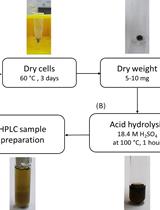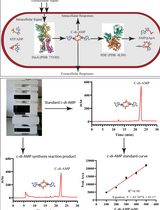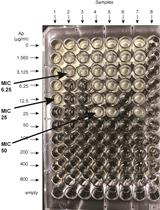- EN - English
- CN - 中文
Quantitative Determination of Poly-β-hydroxybutyrate in Synechocystis sp. PCC 6803
集胞藻PCC 6803中聚-β-羟基丁酸的定量测定
发布: 2017年07月20日第7卷第14期 DOI: 10.21769/BioProtoc.2402 浏览次数: 9384
评审: Maria SinetovaAnonymous reviewer(s)

相关实验方案

酸水解-高效液相色谱法测定集胞藻PCC 6803中聚3-羟基丁酸酯的含量
Janine Kaewbai-ngam [...] Tanakarn Monshupanee
2023年08月20日 1734 阅读

基于高效液相色谱法的史氏分枝杆菌DisA环二腺苷酸(C-di-AMP)合成酶活性研究
Avisek Mahapa [...] Dipankar Chatterji
2024年12月20日 1692 阅读
Abstract
Cyanobacteria synthesize a variety of chemically-different, high-value biopolymers such as glycogen (polyglucose), poly-β-hydroxybutyrate (PHB), cyanophycin (polyamide of arginine and aspartic acid) and volutin (polyphosphate) under excess conditions. Especially under unbalanced C to N ratios, glycogen and in some cyanobacterial genera also PHB are massively accumulated in the progression of the general nitrogen stress response. Several different technologies have been established for in situ and in vitro PHB analysis from different microbial sources. In this protocol, a rapid and reliable spectrophotometric method is described for PHB quantification in the cyanobacterium Synechocystis sp. PCC 6803 upon nitrogen deprivation as described in (Damrow et al., 2016).
Keywords: Cyanobacteria (蓝藻)Background
Non-diazotrophic cyanobacteria such as Synechocystis sp. PCC 6803 respond to the lack of combined nitrogen sources by bleaching, a process known as chlorosis (Allen and Smith, 1969). This acclimation response is characterized by four major structural and morphological changes: (i) a massive accumulation of electron-dense glycogen inclusions (approx. 40 nm in diameter) between the thylakoid layers accompanied by (ii) the degradation of the phycobilisome antenna complexes, (iii) the disassembling of the thylakoid membrane layers including a reduction by number and packing density, and (iv) the formation of distinct electron-transparent PHB granules (approx. 400-500 nm in diameter) (Damrow et al., 2016). The physiological function of cyanobacterial PHB metabolism, synthesized just in a few species, is quite opaque due to the absence of both catabolic enzymes and evident phenotype of PHB-deficient mutants (Beck et al., 2012; van der Woude et al., 2014; Damrow et al., 2016; Namakoshi et al., 2016).
Facing the world’s trash and global warming crisis, the demands for durable, recyclable, biodegradable, and synthetic-alternative plastics such as PHB is enormous and focus attention to cyanobacterial producers (Asada et al., 1999; Ansari and Fatma, 2016). Various different techniques are published for the analysis of PHB molecules (for updated review see [Godbole, 2016]). We are presenting a combination of hydrolytic degradation of PHB to 3-hydroxybutyrate (3-HB) in alkaline regime, and a coupled colorimetric enzymatic assay. Here the coupling with a phenazine methosulphate-p-iodonitrotetrazolium violet (PMS-INT) system directs the enzymatic redox reaction of both NADH oxidation and 3-HB reduction by the 3-hydroxybutyrate dehydrogenase (HBDH) and thus precludes an interfering backward reaction. This rapid spectrophotometric quantification of PHB just needs very simple lab equipment, is not much time-consuming, and is yet both reliable and reproducible.
Materials and Reagents
- Pipette tips
- 1.5 ml centrifuge tubes (Eppendorf® Safe-Lock microcentrifuge tubes) (Eppendorf, catalog number: 0030120086 )
- 15 ml centrifuge tubes (TubeSpin® Bioreactor 15) (TPP Techno Plastic Products, catalog number: 87015 )
- 50 ml centrifuge tubes (TubeSpin® Bioreactor 50) (TPP Techno Plastic Products, catalog number: 87050 )
- Synechocystis sp. PCC 6803 cells (Pasteur culture collection of cyanobacteria) (Institut Pasteur, catalog number: PCC 6803 )
- Crushed ice
- Bi-distilled water
- 0.5 N sodium hydroxide (NaOH) (Carl Roth, catalog number: 9356.1 )
- 1 N hydrochloric acid (HCl-ROTIPURAN® 37%) (Carl Roth, catalog number: X942.1 )
- 50 mM Tris-hydrochloride, pH 8.5 (PUFFERAN® ≥ 99%) (Carl Roth, catalog number: 9090.3 )
- 20 mM β-Nicotinamide adenine dinucleotide (NADH/H+), reduced disodium salt (Sigma-Aldrich, catalog number: N9785 )
Note: This product has been discontinued. - 1 mM β-Nicotinamide adenine dinucleotide (NAD+), reduced disodium salt (Sigma-Aldrich, catalog number: N0632 )
- 5 mM phenazine methosulfate (PMS) (Sigma-Aldrich, catalog number: P9625 )
- 5 mM p-Iodonitrotetrazolium violet (INT) (Sigma-Aldrich, catalog number: I8377 )
- 1 mM (R)-3-hydroxybutyric (R-3-HB) (Sigma-Aldrich, catalog number: 54920 ) with a molar mass of 104.10 g/mol
- 15 U/ml 3-hydroxybutyrate dehydrogenase (3-HBDH) grade II from Rhodobacter spheroides (Roche Diagnostics, catalog number: 10127833001 )
- BG11 stock solution ‘+N’; autoclaved (use 1:100) (see Recipes)
- Sodium nitrate (NaNO3 ≥ 99%, p.a., ACS, ISO) (Carl Roth, catalog number: A136.1 )
- Calcium chloride dihydrate (CaCl2·2H2O ≥ 99%, p.a., ACS) (Carl Roth, catalog number: 5239.1 )
- Citric acid (C6H8O7 ≥ 99.5%, p.a., ACS, anhydrous) (Carl Roth, catalog number: X863.1 )
- Magnesium sulfate heptahydrate (MgSO4·7H2O ≥ 99%, p.a., ACS) (Carl Roth, catalog number: P027.1 )
- Ethylenediamine tetraacetic acid disodium salt dehydrate (EDTA ≥ 99%, p.a., ACS) (Carl Roth, catalog number: 8043.2 )
- BG110 stock solution ‘-N’; autoclaved (use 1:100) (see Recipes)
- Calcium chloride (CaCl2·2H2O ≥ 99%, p.a., ACS) (Carl Roth, catalog number: 5239.1 )
- Citric acid (C6H8O7 ≥ 99.5%, p.a., ACS, anhydrous) (Carl Roth, catalog number: X863.1 )
- Magnesium sulfate (MgSO4·7H2O ≥ 99%, p.a., ACS) (Carl Roth, catalog number: P027.1 )
- Ethylenediamine tetraacetic acid disodium salt dehydrate (EDTA ≥ 99%, p.a., ACS) (Carl Roth, catalog number: 8043.2 )
- Trace Metal Mix for BG11; sterile filtrated (use 1:1,000) (see Recipes)
- Boric acid (H3BO3) (≥ 99.8%, p.a., ACS, ISO) (Carl Roth, catalog number: 6943.2 )
- Manganese(II) chloride tetrahydrate (MnCl2·4H2O ≥ 99%, p.a.) (Carl Roth, catalog number: T881.3 )
- Zinc sulfate heptahydrate (ZnSO4·7H2O ≥ 97%, extra pure) (Carl Roth, catalog number: 7316.1 )
- Sodium molybdate dihydrate (Na2MoO4·2H2O), ≥ 99.5% (Sigma-Aldrich, catalog number: M1651 )
- Cupric(II) sulfate pentahydrate (CuSO4·5H2O ≥ 99%, Ph.Eur., BP) (Carl Roth, catalog number: P025.1 )
- Cobalt(II) nitrate hexahydrate (Co(NO3)2·6H2O) (Sigma-Aldrich, catalog number: 203106 )
- Extra solutions for BG11; sterile filtrated (use 1:1,000) (see Recipes)
- Ammonium iron(III) citrate (Carl Roth, catalog number: 9366.1 )
- Potassium phosphate dibasic (K2HPO4 ≥ 98%, Ph.Eur., BP) (Carl Roth, catalog number: T875.1 )
- Sodium carbonate carbonate monohydrate (Na2CO3·H2O ≥ 99.5%, p.a., ACS) (Carl Roth, catalog number: 2597.2 )
- Buffer solution for BG11; autoclaved (use 1:200) (see Recipes)
1 M HEPES buffer (pH 8.0) (PUFFERAN® ≥ 99.5%) (Carl Roth, catalog number: 9105.4 ) - BG11 (‘+N’) medium (see Recipes)
- BG110 (‘-N’) medium (see Recipes)
Equipment
- Wide-neck 500 ml Erlenmeyer flasks (Carl Roth, DURAN®, catalog number: C150.1 )
- Personal protective equipment (PPE)
Note: These should be worn at all times when dealing with concentrated acids and alkali. See Note 3. - Safety glasses (Sekuroka®-safety glasses EN166) (Carl Roth, catalog number: Y254.1 )
- Lab coat (Sekuroka®-lab coats) (Carl Roth, catalog number: T413.1 )
- Gloves (Rotiprotect®-nitrile evo) (Carl Roth, catalog number: CPX7.1 )
- Pipette set (Rainin Pipet-Lite LTS Starter Kit L-STARTXLS+) (Mettler-Toledo International, catalog number: 17014406 )
- Ice bucket
- Laminar flow bench (Thermo Fisher Scientific, Thermo ScientificTM, model: MSC-AdvantageTM Class II , catalog number: 51028225)
- Analytical balance (Mettler-Toledo International, model: XS105 )
- Centrifuge (Thermo Fisher Scientific, Thermo ScientificTM, model: HeraeusTM BiofugeTM Primo R , catalog number: 75005440)
- Light meter (LI-COR, model: LI-189 )
- Incubator (Infors, model: Multitron Pro , ‘Algae Special’)
- UV-Vis spectrophotometer (Analytic Jena, model: Specord® 50 PLUS )
- Bench pH/mV/°C meter (pH 1,000 L, pHenomenal®) (VWR, catalog number: 662-1422 )
- Thermomixer (Biometra, model: ThermoShaker TS1 , catalog number: 846-051-500)
- Vortex shaker (VWR, Peqlab, model: peqTWIST )
- Autoclave (Systec, model: Systec VX-150 )
Procedure
文章信息
版权信息
© 2017 The Authors; exclusive licensee Bio-protocol LLC.
如何引用
Zilliges, Y. and Damrow, R. (2017). Quantitative Determination of Poly-β-hydroxybutyrate in Synechocystis sp. PCC 6803. Bio-protocol 7(14): e2402. DOI: 10.21769/BioProtoc.2402.
分类
微生物学 > 微生物生物化学 > 其它化合物
生物化学 > 其它化合物 > 聚-β-羟基丁酸
您对这篇实验方法有问题吗?
在此处发布您的问题,我们将邀请本文作者来回答。同时,我们会将您的问题发布到Bio-protocol Exchange,以便寻求社区成员的帮助。
Share
Bluesky
X
Copy link










